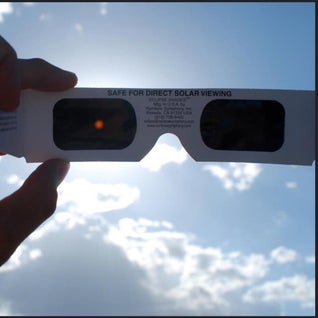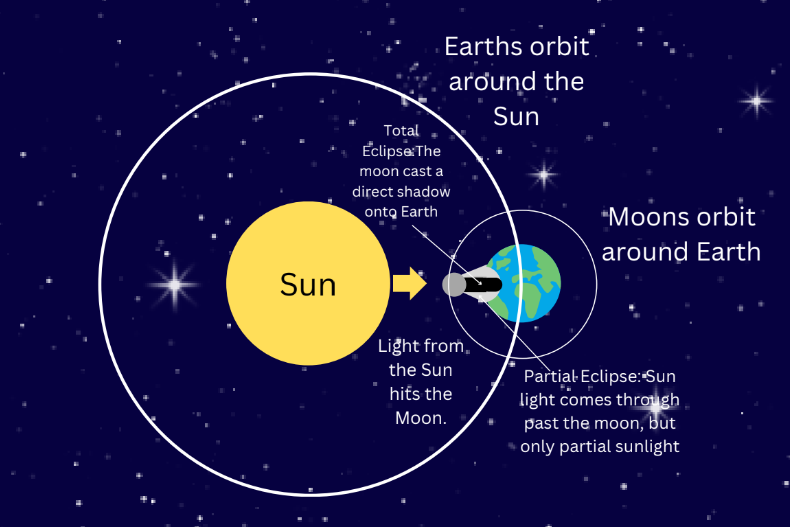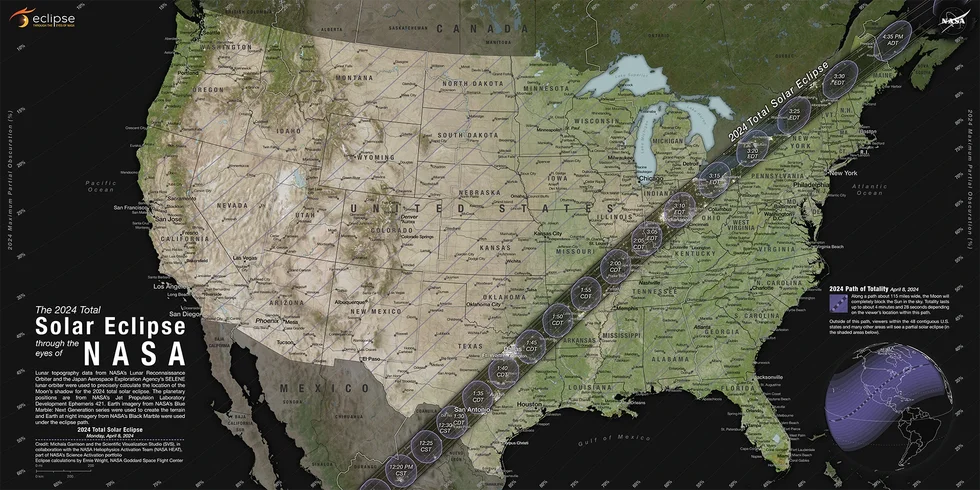A campus under an Eclipse
As the Sun slowly disappeared behind the moon, and the daylight seemed to dim, there was a place that came together to witness what happens only a few times a lifetime.
Marshall Universities campus rallied together on Monday, April 8, as an eclipse cast a shadow over its school, missing totality by just a state apart.
Students, faculty, staff, professors, alumni, friends and family all gathered outside starting around noon, slowly adding to their numbers with more coming to see as the time ticked closer to 3:12 that afternoon, the expected time the moon would be blocking the sun the most in the region.
Bring out the Science
Festivities began around noon, with WMUL setting up speakers and a portable dj table for students to make requests. Alongside them, the Society of Physics and Astronomy Club collaborated to create a viewing of the eclipse on a TV screen for those without solar glasses to watch.
Using a large white telescope with a solar filter blocking over 99% of sunlight, the Moon's shadow over the Sun was cast onto the screen for anyone to see.
Owen Gibson, a member of the astronomy club, was working the telescope that would show the eclipse on screen, and said that the image shown from the smaller telescope they had would show the sun as white instead of orange, as that is it's actual color. Gibson says just like a rainbow, the sun emits all colors, making it actually white light that is emitted.
Gibson on how his telescope works, the eclipse, and how he feels about the event.
Beside Gibson was the Physics table where Sidney Moore, a member of the Physics Society, was handing out viewing glasses for the eclipse. Despite bringing around 1,500 glasses, Moore said that they had run out after only about half an hour. She said she had hopes people wouldn't decide to just look straight at the sun without any protection, but that there will always be someone who cannot help themselves.
Moore also explained the eclipse and how the shadow would be cast over the Earth.
Moore on the science of the eclipse, what the glasses do, and what happens when they are not used.
Modern technology wasn't the only thing used to view the Sun, as old tricks were brought back to fill in gaps where there were no glasses to spare. Andrew Surber, an Alumni of Marshall, ventured onto campus to view the eclipse with his affordable solution.
Surber created a viewing box that could cast the shadow of the sun into a small container, allowing him to view the eclipse without even needing to look at the Sun. He said all that was needed for it was a small box, some aluminum foil, and a pin to make a small hole at the top, where the shadow would cast though.
Surbur showing how he made his viewing device with just some household items.
As a shadow began to appear over the Sun, more and more people started looking up at the sky, even without eye protection. Wesley Stites, the dean of the college of science, spoke on what he had seen people use to view the eclipse, and why some of these people may find problems with their vision after.
Stites on proper viewing glasses, improper use of them, and other viewing devices he saw used. As Stites mentions, there was a man using welding goggles to look at the sun on campus.

Solar viewing glasses showing the sun through them. Stites said that although they arfe safe to use, they should not be over used to avoid uncom fortablity.
Stites also spoke on how although Huntington was missing totality of the eclipse by just a couple hours drive away, being here with the community was special to him. He also said he was proud of the students taking such an interest in the science aspect of eclipse, both those in his field and out.
Where did the Sun go?
Explained by Gibson, Moore, and Stites, an Eclipse happens when the Moon moves in front of the Sun, blocking the sunlight. Stites spoke on how he could have driven to Ohio to see the total eclipse, but stayed on campus instead, only catching the partial eclipse. This is because Huntington was just outside of the path of totality, where instead of 95% coverage, it was the full 100%. Stites said that's where the ring of fire could be seen, which is the edges of the sun barely coming around the moon.
Stites said "it's (the Moon) not as big as the Sun, but it's just the right distance from the Sun that it appears the same size. If the moon were closer, we wouldn't see the ring, just maybe a glow from it."
"But the reason we, and most of the country, are not going to see the full thing, but still see a change, is due to the partial shadow cased over us," said Stites. He said that a partial Eclipse is the surrounding lighter shadow that is still created by the Moon, just on a lesser scale compared to the path of totality.

How the shadow cased by the Moon affects Earth with a total and partial shadow. The grey is the partial, and the black is the total.
Moore said that we wouldn't be seeing the full eclipse as the Moon wouldn't be casting a shadow directly over the Huntington area, but it was going to be going dark not far away in Cleveland. "Had it started maybe an hour or two later then maybe we would have been in the path."

NASA's map of the path of totality.
The Sun, Moon, and Everyone Watching
Applause and cheers broke out at 3:12, when the Sun was most hidden behind the Moon. Some expected a rapture, some wanted it to be darker, and others watched with amazement.
Many mentioned how much time would pass until they could experience this again. As some said, they would be in their forties possibly with teenagers. Gibson reflected back to his high school years, as that was when he said the last eclipse he experienced was.
Many said it was quite the experience regardless of when it will happen again.
As it can be seen, it doesn't take much to get Marshal's community together, but there couldn't be a better way than by a natural occurrence like an eclipse. Something many could go their whole life without seeing, and definitely not something many can say they experienced in college.
Add comment
Comments